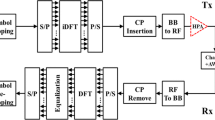Abstract
One of the main drawbacks of conventional transmitted reference (TR) ultra-wideband systems is the fact that time delay between the reference and the data pulse has to be at least equal to channel delay spread, in order to avoid inter-pulse interference (IPI). This requirement drastically limits the achievable data rate of conventional TR systems based on M-ary pulse position modulation (PPM). In this paper, the new method for M-ary TR PPM scheme bandwidth efficiency increasing is proposed. In the proposed method the orthogonal codes are used such that only the pulses which can cause IPI are coded. Usage of such type of coding allows the reduction of time delay between the reference and the data pulse, whereas IPI is avoided. The proposed method achieves higher bandwidth efficiency than the conventional TR PPM method for the similar BEP performance level. Furthermore, the results show that an additional increase in bandwidth efficiency can be achieved by using higher modulation levels. Additionally, the analysis on tradeoffs between the BEP performance, bandwidth reduction and system costs is given in this paper.













Similar content being viewed by others
References
Win, M. Z., & Scholtz, R. A. (1998). On the energy capture of ultra-wide bandwidth signals in dense multipath environments. IEEE Commun Lett, 2(9), 245–247.
Doukeli, A. P., Lioumpas, A. S., Karagiannidis, G. K., & Frangos, P. V. (2012). Increasing the efficiency of rake receivers for ultra-wideband applications. Wireless Pers Commun, 62(3), 715–728.
Jin, Y., Shen, B., & Kwak, K. S. (2012). Improved transmitted reference pulse cluster scheme for ultra wideband communications system. IET Commun, 6(15), 2267–2273.
Liang, Z., Dong, X., Jin, L., & Guliver, T. A. (2012). Improved low-complexity transmitted reference pulse cluster for ultra-wideband communications. IET Commun, 6(7), 694–701.
Xu, Z., Sadler, B. M., & Tang, J. (2005). Data detection for UWB transmitted reference system with inter-pulse interference. In Proceedings of the IEEE international conference on acoustics, speech and signal processing, pp. 601–604.
Kim, D. I., & Jia, T. (2008). M-ary orthogonal coded/balanced ultra-wideband transmitted-reference system in multipath. IEEE Trans Commun, 56(1), 102–111.
Dong, X., Lee, A. C. Y., & Xiao, L. (2005). A new UWB dual Pulse Transmission and detection technique. In Proceedings of the IEEE international conference on communications, pp. 2835–2839.
Jia, T., & Kim, D. I. (2008). Multiple access performance of balanced UWB transmitted-reference systems in multipath. IEEE Trans Wireless Commun, 7(3), 1084–1094.
Sinae, J., Sengjoo, L., & Jaeseok, K. (2013). Efficient hybrid modulation with phase-directed pulse position estimation for UWB-IR systems. IEEE Trans Wireless Commun, 61(3), 1171–1177.
Erkucuk, S., & Kim, D. I. (2007). M-ary code shift keying impulse modulation combined with BPPM for UWB communications. IEEE Trans Wireless Commun, 6(6), 2255–2265.
Abou-Rjeily, C., & Belfiore, J. C. (2007). On space-time coding with pulse position and amplitude modulations for time-hopping ultra-wideband systems. IEEE Trans Inf Theory, 53(7), 2490–2509.
Li, L., & Townsend, J. K. (2010). M-ary PPM for transmitted reference ultra-wideband communications. IEEE Trans Wireless Commun, 58(7), 1912–1917.
Molisch, A. F., Foerster, J. R., & Pendergrass, M. (2003). Channel models for ultrawideband personal area networks. IEEE Wireless Commun, 10(6), 14–21.
Jia, T., & Kim, D. I. (2007). Analysis of channel-averaged SINR for indoor UWB rake and transmitted reference systems. IEEE Trans Commun, 55(10), 2022–2032.
Li, L., Townsend, J. K., & Ulman, R. J. (2008). Multiple-access performance of transmitted reference UWB communications with M-ary PPM. In Proceedings of the IEEE global telecommunications conference, pp. 1–6.
Proakis, J. G. (2001). Digital communications. New York: McGraw-Hill.
Author information
Authors and Affiliations
Corresponding author
Rights and permissions
About this article
Cite this article
Milanovic, J., Herceg, M., Vranjes, M. et al. Method for Bandwidth Efficiency Increasing of M-ary PPM Transmitted-Reference UWB Communication Systems. Wireless Pers Commun 83, 1927–1944 (2015). https://doi.org/10.1007/s11277-015-2495-y
Published:
Issue Date:
DOI: https://doi.org/10.1007/s11277-015-2495-y




